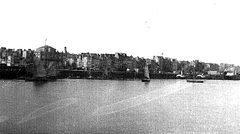Sailing at the 1920 Summer Olympics
| Sailing at the Games of the VII Olympiad |
||||||||||||||||
|---|---|---|---|---|---|---|---|---|---|---|---|---|---|---|---|---|

Poster Anvers 1920
|
||||||||||||||||
| Venues |
Ostend Amsterdam |
|||||||||||||||
| Dates | First race: 7 July 1920 (Ostend) Last race: 10 July 1920 Final race: 3 September 1920 (Amsterdam) |
|||||||||||||||
| Sailors | 100 Male and 1 Female from 6 countries | |||||||||||||||
| Boats | 24 | |||||||||||||||
| Top ranked countries | ||||||||||||||||
|
||||||||||||||||
| Royal Yacht Club of Belgium | |
|---|---|
| Royal Yacht Club van België | |

|
|
| General information | |
| Status | unknown |
| Type | Clubhouse |
| Country |
|
| Coordinates | 51°14′2″N 2°55′25″E / 51.23389°N 2.92361°E |
| Elevation | Sealevel |
Sailing/Yachting is an Olympic sport starting from the Games of the 1st Olympiad (1896 Olympics in Athens, Greece). With the exception of 1904 and possible 1916 sailing was always a part of the Olympic program. The Sailing program of 1920 was open for a total of sixteen sailing classes (disciplines), but actually only fourteen Sailing events were contested, because of at the 8.5 metre and 9 metre classes there were no entrants. For each class three races were scheduled from 7 July 1920 to 10 July 1920 off the coast of Ostend at the North Sea.
Ostend offers a fair condition for sailing on the North Sea. However, there are tidal conditions the current is reasonable predictable. Local knowledge does not have too much influence of the races. The wind conditions are also good for sailing. However, in the case of the 1920 Summer Olympic regatta's the prevailing breeze did not show. Most races had to be sailed under light air conditions.
An unprecedented and unique Olympic situation happened with the races in the 12' Dinghy. When in the second race one of the marks was taken hostage by the tidal current and went drifting the race had to be nullified. Since the organizers did not have the time to resail the race and both teams were of Dutch origin the Belgian organization requested the Dutch Olympic Committee to resail the finals in The Netherlands. As a result, the first Olympic event held in the Netherlands was not in 1928 but already in 1920. As venue of this final the Buiten IJ in Amsterdam was chosen.
A maximum of 2 boats per country per class was allowed.
Source:
Source: The Olympic Sailing event of 1920 was without any doubt the most strangest in history so far. With a program of no less than 16 classes and an entry list that consists of 7 out of 14 classes with just competitor and only one class with more than 3 yachts.
After World War I the International Sailing Authority had obvious no clue in what direction sailing had developed since 1912. The Nordic countries had developed the Skerry Cruiser classes and the International rule classes had adopted in 1919 a new edition of the rule which was not yet implemented in the countries. Therefore, the entries were open for the old, as well the new rule and two Skerry classes. Besides that, an advice from 1908 was followed by putting two one design classes on the program. By doing this the 1920 Olympics acted as a test laboratory from which the IYRU could draw conclusion for the further development of the sport. These lessons learned, not too many different classes and moving towards one design classes, did show during the next Olympic Sailing event and are still taken into account.
...
Wikipedia
